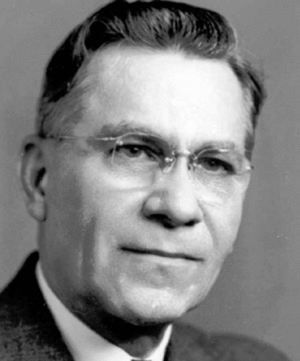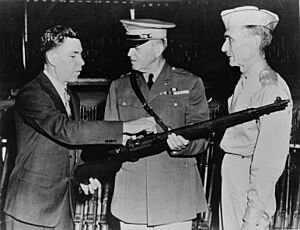John Garand facts for kids
Quick facts for kids
John C. Garand
|
|
|---|---|
 |
|
| Born |
Jean Cantius Garand
January 1, 1888 St. Rémi, Quebec, Canada
|
| Died | February 16, 1974 (aged 86) |
| Nationality | Canadian, American |
| Occupation | Designer, Engineer |
| Years active | 1917–1953 |
| Employer | Springfield Armory |
| Known for | First successful semi-automatic rifle adopted as a primary service rifle by a major military power. |
|
Notable work
|
United States Rifle, Caliber .30, M1 (M1 Garand) |
| Spouse(s) |
Nellie Bruce Shepard
(m. 1930) |
| Children | 3 |
| Awards | Meritorious Civilian Service Award in 1941 Medal for Merit in 1944 |
John C. Garand (born Jean Cantius Garand on January 1, 1888 – died February 16, 1974) was a very important inventor. He was a Canadian-American designer of firearms. He created the famous M1 Garand rifle. This semi-automatic rifle was used a lot by the U.S. Army and U.S. Marine Corps. It was a key weapon during both World War II and the Korean War.
Contents
Early Life and Learning
John C. Garand was born on a farm in St. Rémi, Quebec, Canada. He was one of twelve children in his family. When his mother passed away in 1899, his father moved the family to Jewett City, Connecticut.
John and his brothers worked in a textile mill. This is where John learned to speak English. He started by sweeping floors. John also became very interested in guns. He learned how to shoot at a shooting gallery.
He gained useful skills as a machinist at the textile mill. In 1909, he got a job at Browne and Sharpe. This was a toolmaking company in Providence, Rhode Island. Later, in 1916, he worked for another toolmaking firm in New York. He kept practicing his shooting skills there. John Garand became a citizen of the United States in 1920.
His last name, Garand, is often said in different ways. However, his family and close friends agree it sounds like 'errand'.
Designing Firearms

John Garand loved machines and target shooting. This led him to design guns as a hobby. In 1917, his hobby became his job. The United States Army was looking for new designs for a light machine gun. Garand's design was chosen by the War Department.
He was given a job with the United States Bureau of Standards in Washington D.C.. His task was to make his weapon design perfect. The first model was finished in 1919. This was too late for World War I. But the government kept John Garand working as an engineer. He worked at the Springfield Armory from November 4, 1919, until he retired in 1953.
Creating the M1 Garand Rifle

At Springfield, Massachusetts, Garand was asked to design a new type of rifle. This rifle needed to be a gas-actuated self-loading infantry rifle. It would use gas pressure to eject the used cartridge and load a new one. This was a challenging project.
It took fifteen years to make the M1 rifle perfect. It had to meet all the U.S. Army's requirements. The final rifle was called the Semiautomatic, Caliber .30, M1 Rifle. Garand received a patent for it in 1932. The U.S. Army approved it on January 9, 1936. Mass production of the rifle began in 1940.
The M1 Garand replaced the older bolt-action M1903 Springfield rifle. It became the standard rifle for soldiers. During World War II, over four million M1 rifles were made. The Garand Rifle was known for being effective and reliable. Famous generals praised it. General MacArthur liked it very much. General Patton even said it was "the greatest battle implement ever devised."
In the late 1940s and early 1950s, Garand designed another rifle. It was a prototype of a bullpup rifle. This design was very different from the M1. It could fire very quickly, about 600 rounds per minute. When Garand retired in 1953, this new rifle was not finished. The project was stopped. The prototype is now in the Springfield Armory museum.
John Garand never made money from his M1 rifle design. He gave all the rights to his inventions to the U.S. government on January 20, 1936. There was a plan in Congress to give him $100,000. This was to show thanks for his work. However, the plan did not pass. Garand continued to work as a consultant at the Springfield Armory until he retired in 1953.
Personal Life
John Garand married Nellie Bruce Shepard on September 6, 1930. She was a French Canadian widow. She already had two daughters. Together, John and Nellie had a daughter and a son.
John C. Garand passed away in Springfield, Massachusetts, on February 16, 1974. He was buried at Hillcrest Park Cemetery.
Recognition and Awards
John Garand received many honors for his work. In 1941, he was given the Meritorious Civilian Service Award. He also received the Alexander L. Holley Medal. This was from the American Society of Mechanical Engineers.
On March 28, 1944, he received the first Medal for Merit. This was a very high civilian award. In 1973, Garand was added to the U.S. Army Ordnance Corps Hall of Fame. This was for designing the M1 Rifle, also known as The Garand.
The Hall of Fame recognized his amazing talent. They said his inventions gave U.S. soldiers a big advantage in World War II. His skill and determination helped create many tools. These tools were needed to make the "Garand Rifle." He was a true engineering genius. His work played a very important part in the history of World War II.


